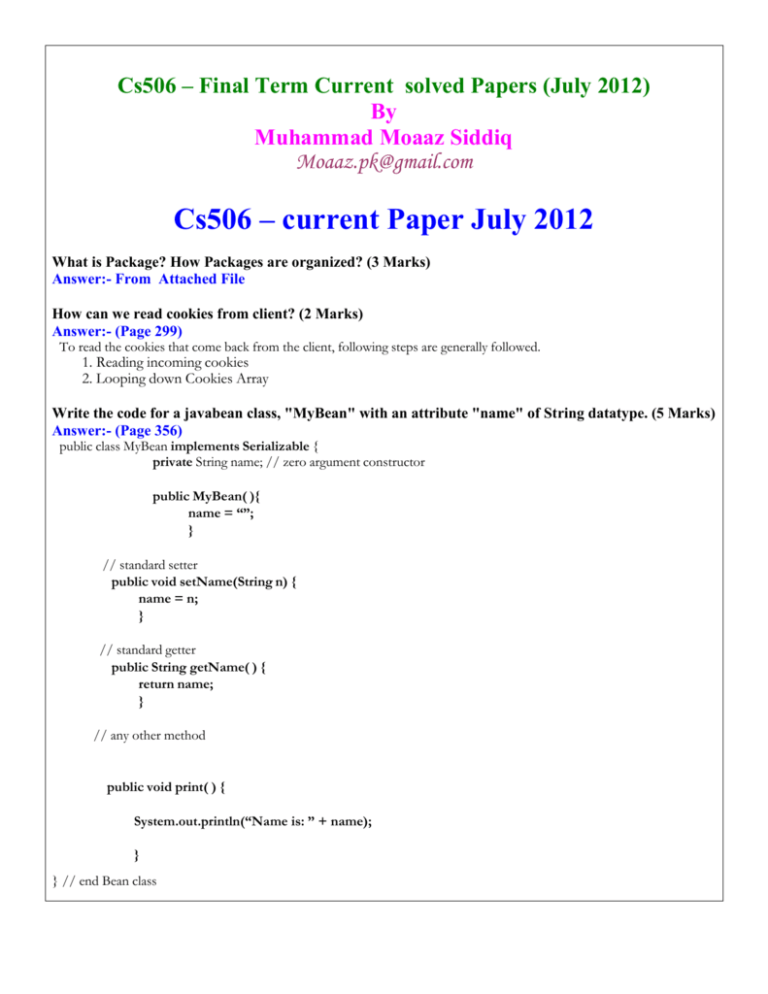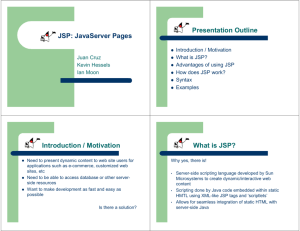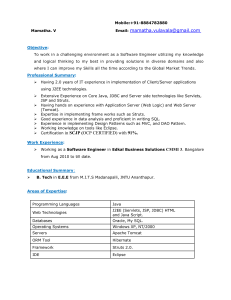Cs506 – Final Term Current solved Papers (July 2012)
advertisement

Cs506 – Final Term Current solved Papers (July 2012)
By
Muhammad Moaaz Siddiq
Moaaz.pk@gmail.com
Cs506 – current Paper July 2012
What is Package? How Packages are organized? (3 Marks)
Answer:- From Attached File
How can we read cookies from client? (2 Marks)
Answer:- (Page 299)
To read the cookies that come back from the client, following steps are generally followed.
1. Reading incoming cookies
2. Looping down Cookies Array
Write the code for a javabean class, "MyBean" with an attribute "name" of String datatype. (5 Marks)
Answer:- (Page 356)
public class MyBean implements Serializable {
private String name; // zero argument constructor
public MyBean( ){
name = “”;
}
// standard setter
public void setName(String n) {
name = n;
}
// standard getter
public String getName( ) {
return name;
}
// any other method
public void print( ) {
System.out.println(“Name is: ” + name);
}
} // end Bean class
What technology is used in Java, that supports the following; (5 Marks)
Presentation Layer
Business Layer
Data Layer
Answer:- From Attached File
How can we use Attached FileReader and Attached FileWriter streams to print on console? (2 Marks)
Answer:- (Page 87)
Classes with the word stream in their name are byte- oriented in nature. Classes which contain the word
Reader/Writer are character oriented and read and write data in the form of characters.
Write the name of three types of Custom Tags? (3 Marks)
Answer:- (Page 379)
Three types of can be constructed. These are:
1-Simple Tag
2-Tag with Attribute
3-Tag with Body
Differentiate between encodeURL() and encodeRedirectURL()? (2 Marks)
Answer:- From Attached File
Cs506 – current Paper July 2012
What are advantages of jsp over PHP?
Answer:- From Attached File
Why use client side validation?
Answer:- From Attached File
2
2
Character oriented vs. byte oriented stream? 2
Answer:- Click here for detail
A byte stream accesses the Attached File byte by byte. A byte stream is suitable for any kind of Attached
File, however not quite appropriate for text Attached Files.
A character stream will read a Attached File character by character. A character stream needs to be given the
Attached File's encoding in order to work properly.
Does JSP support run time exception handling if yes then how? 2
Answer:- (Page 393)
Yes , JSP support run time exception handling by following mechanism
•isErrorPage attribute of a page directive is used to declare a JSP as an error page.
•JSP pages are informed about the error page by setting errorPage attribute of page directive
Advantages of JSP over servlet?
Answer:- From Attached File
3
Difference between variable declared inside declaration part and scriplet part? 3
Answer:- From Attached File
Why not use = = operator to compare string object of equal value? 3
Answer:For comparing Strings never use = = operator, use equals method of String class.
= = operator compares addresses (shallow comparison) while equals compares values (deep comparison)
Why need expression languages?
Answer:- From Attached File
3
What does it means method or class abstract?
5
Answer:- (Page 96)
Abstract classes are used to define only part of an implementation. Because, information is not complete
therefore an abstract class cannot be instantiate. However, like regular classes, they can also contain instance
variables and methods that are full implemented. The class that inherits from abstract class is responsible to
provide details.
Any class with an abstract method (a method has no implementation similar to pure virtual function in
C++) must be declared abstract, yet you can declare a class abstract that has no abstract method.
If subclass overrides all abstract methods of the super class, than it becomes a concrete (a class whose object
can be instantiate) class otherwise we have to declare it as abstract or we can not compile it.
The most important aspect of abstract class is that reference of an abstract class can point to the object of
concrete classes.
Why need JSP as we have servlet?
Answer:- (Page 330)
5
The Need for JSP
With servlets, it is easy to
—
Read form data
—
Read HTTP request headers
—
Set HTTP status codes and response headers
—
Use cookies and session tracking
—
Share data among servlets
—
Remember data between requests
—
Get fun, high-paying jobs
But, it sure is a pain to
—
Use those println()statements to generate HTML
—
Maintain that HTML
The JSP Framework
—
Use regular HTML for most of the pages
—
Mark servlet code with special tags
—
Entire JSP page gets translated into a servlet (once), and servlet is what actually gets invoked
(for each request)
—
The Java Server Pages technology combine with Java code and HTML tags in the same
document to produce a JSP Attached File.
What impact have java bean object can produce when it store in session objects? 5
Answer:- (Page 373)
in addition to being bound to local variable, the bean object will be stored in the HttpSession object
associated with the current request. As you already know, object’s value stored in HttpSession persists for
whole user’s session. The figure below helps in understanding this concept.
In the diagram above, MyBean is instantiated by specifying scope = “session”that results in storing object in
HttpSession. A value “ali” is also stored in m using setter method.
Irrespective of request forwarding or new request generation from second.jsp to other resources, the values
stored in HttpSession remains available until user’s session is ended.
Difference between page centric and page with beans approach?
Answer:- From Attached File
5
Cs506 – current Paper July 2012
1 write any two implicit objects (2)
Answer:- From Attached File
2 describe servlet context (2)
Answer:- From Attached File
3 why this keyword is used if we not use it then what will be he problems (2)
Answer:- http://www.java-samples.com/showtutorial.php?tutorialid=282
this can be used inside any method to refer to the current object. That is, this is always a reference to the
object on which the method was invoked. You can use this anywhere a reference to an object of the current
class' type is permitted.
3 stages of servlet life cycle (3)
Answer:- From Attached File
5 why session tracking is necessary (5)
Answer:- From Attached File
6 why the expression language is used (3)
Answer:- rep
7 describe twin libraries (5)
Answer:- (Page 469)
Twin Tag Libraries
JSTL comes in two flavors to support various skill set personal
Expression Language (EL) version
- Dynamic attribute values of JSTL tags are specified using JSTL expression language (i.e. ${expression})
- The EL based JSTL tag libraries along with URIs and preferred prefixes are given below in tabular format
Request Time (RT) version
- Dynamic attribute values of JSTL tags are specified using JSP expression
(i.e. <%= expression %>)
- The RT based JSTL tag libraries along with URIs and preferred prefixes are given below in tabular format
8 why there is no global variable in java(5)
Answer:- (Page 41)
There are no global variables or functions. Everything resides inside a class.
9 for what purpose the c:remove is used in JSTL(2)
Answer:- From Attached File
10 explain the JSP life cycle (5)
Answer:The life cycle methods of JSP are jspInit(), _jspService() and jspDesroy(). On receiving each request,
_jspService() method is invoked that generates the response as well.
Cs506 – current Paper July 2012
1) Why we use servlets in the place of JSP controller?
Answer:- https://forums.oracle.com/forums/thread.jspa?threadID=2058739
servlets are better suited to business logic and JSP's are better suited to view components.
2) Differentiae between page centric approach and page with bean approach ?
Answer:- rep
3) Why we use taglib?
Answer:- http://www.roseindia.net/jsp/jsptaglibraries.shtml
It is used to create custom tag in jsp.
4) Why we use JSP action elements and what are there formats?
Answer:- From Attached File
5) Why we use JSP directive and describe its format?
Answer:- From Attached File
Give high level information about servlet that will result from JSP page. It can be used anywhere in the
document. It can control
Which classes are imported
What class the servlet extends
What MIME type is generated
How multithreading is handled
If the participates in session
Which page handles unexpected errors etc.
6) Differentiate between encode URL() and redirect URL()?
Answer:- From Attached File
7) What are hidden form fields?
Answer:- (Page 312)
Hidden Forms Fields do not affect the appearance of HTML page. They actually contain the information that
is needed to send to the server. Thus, hidden fields can also be used to store information (like sessionid) in
order to maintain session.
8) Write the procedure for adding information in clients’s URL?
Answer:- From Attached File
This information can be in the form of:
.
Extra path information,
.
Added parameters, or
.
Some custom, server-specific URL change
9) What is the difference between Request Dispatcher forward , and Request dispatcher Include?
Answer:- (Page 282)
Request Dispatcher: forward
Characteristics of forward methods are:
It allows a Servlet to forward the request to another resource (Servlet, JSP or HTML Attached File) in
the same Servlet context.
Forwarding remains transparent to the client unlike res.sendRedirect(String location). You can not see
the changes in the URL.
Request Object is available to the called resource. In other words, it remains in scope.
Before forwarding request to another source, headers or status codes can be set, but output content
cannot be added.
Request Dispatcher: include
It allows a Servlet to include the results of another resource in its response. The two major differences from
forward are:
Data can be written to the response before an include
The first Servlet which receive the request, is the one which finishes the response
10) Built an interface in which an button and label is shown on first click it shows
”My name is Omer” on second click it shows “My age is 20 years old” on third click it again shows
”My name is Omer” and cycle goes on.
Cs506 – current Paper July 2012
-Why we use session tracking 2 marks
Answer:- rep
-What are page error and how it handle in JSP 2marks
Answer:- (Page 393)
Error Pages enables you to customize error messages. You can even hide them from the user's view entirely,
if you want. This also makes possible to maintain a consistent look and feel throughout an application, even
when those dreaded error messages are thrown.
-web service according to W3C 2 marks
Answer:- From Attached File
-For what purpose c:remove tag is used. (2marks)
Answer:- From Attached File
- What are advantages of jsp over Servlets 3 marks
Answer:- From Attached File
-EJBs and JSP/servlet run on which server? 3marks
Answer:- (Page 439)
JSP and Servlets runs in a web server where as EJBs requires an application server. But, generally application
server contains the web server as well.
-What is impact a java bean object can produce when it is stored in an application 3 marks
Answer:- rep
-Diff b/w serialized and deserializaed 3marks
Answer:serialization - Turn data into a stream of bytes
deserialization - Turn a stream of bytes back into a copy of the original object.
- Why need JSP as we have servlet? 5 marks
Answer:- rep
- What are validators? and there types 5 marks
Answer:- From Attached File
- How streams handle in Java 5marks
Answer:- (Page 86)
Based on functionality streams can be categorized as Node Stream and Filter Stream. Node Streams are
those which connect directly with the data source/sick and provide basic functionality to read/write data from
that source/sink
Attached FileReader fr = new Attached FileReader(“input.txt”);
FilterStreams sit on top of a node stream or chain with other filter stream and provide some additional
functionality e.g. compression, security etc. FilterStreams take other stream as their input.
BufferedReader bt = new BufferedReader(fr);
BufferedReader makes the IO efficient (enhances the functionality) by buffering the input before delivering.
And as you can see that BufferedReader is sitting on top of a node stream which is Attached FileReader.
Cs506 – current Paper July 2012
1. How JSP pages are informed about error pages? (2)
Answer:- rep
2. What happens if a class does not provide a constructor in a class? (2)
Answer:- http://wiki.answers.com/Q/What_happens_if_a_constructor_is_not_defined_in_class
Nothing happens. The compiler successfully compiles the class. When a class does not have a specific
constructor, the compiler places a default no argument construtor in the class and allows you to compile and
execute the class.
3. What are two ways of request dispatching? Explain. (2)
Answer:- rep
4.What type of problems persists with struts framework? (2)
5.What are the participants of MVC model and what are their responsibilities? (3)
Answer:model, view & controller
The model represents the state of the component (i.e. its data and the methods required to manipulate
it) independent of how the component is viewed or rendered.
The view renders the contents of a model and specifies how that data should be presented.
The controller translates interactions with the view into actions to be performed by the model. In a
web application, they appear as GET and POST HTTP requests.
6. Can an arraylist contain heterogeneous objects? If yes then why? (3)
Answer:- http://informstore.blogspot.com/2008/10/java-q.html
Yes a ArrayList can contain heterogenous objects. Because a ArrayList stores everything in terms of Object.
7.How can we read cookies from client? (3)
Answer:- rep
8.EJBs and JSP/Servlets run on which type of server? (3)
Answer:- rep
9.Write down java code to create a dialogue box. (5)
Answer:- (Page 123)
import java.awt.*;
import javax.swing.*;
import java.awt.event.*;
public class ActionEventTest implements ActionListner{
JFrame frame;
JButton hello; //variable for creating GUI component
public void initGUI(){
frame = new JFrame(); //top level container
Container cont = frame.getContentPane(); //get the component area of top level container
cont.setLayout(new FlowLayout());
//Apply layout to that component area
hello = new JButton("Hello");
process}
hello.addActionListener(this);
cont.add(hello);
//creat and add component{Creating event generator step-1 of our
frame.setDefaultCloseOperation(JFrame.EXIT_ON_CLOSE); //set size of the frame and make it visible
frame.setSize(150,150);
frame.setVisible(true);
}
public ActionEventTest(){ // constructor
initGUI();
}
//implementation of actionPerformed method of ActionListener’s interfacemethod of which will be called
when event takes place (second part of step 2 of our process)
public void actionPerformed(ActionEvent event){
JOptionPane.showMessageDialog(null,"Hello is pressed");
}
public static void main(String args[]){
ActionEventTest aeTest = new ActionEventTest();
}
}
10.What is package? How are they organized? (5)
Answer:- From Attached File
11.Differentiate between value binding and method binding. (5)
Answer:- (Page 487)
JSF – Value Binding
Value binding expressions can be used inside of JSF components to:
Automatically instantiate a JavaBean and place it in the request or session scope.
Override the JavaBean's default values through its accessor methods.
Quickly retrieve Map, List, and array contents from a JavaBean.
Synchronize form contents with value objects across a number of requests.
The syntax of binding expressions is based on the JavaServer Pages (JSP) 2.0 Expression Language. In JSP,
expressions are
delimited
with "${}", but
in
JSF they are
delimited
with
"#{}".
JSF – Method Binding
Unlike a value binding, a method binding does not represent an accessor method. Instead, a method binding
represents
an
activation
method.
For example, binding an event handler to a method
<h:commandButton ……
……… />
actionListener=“#{customer.loginActionListener}”
12.What is expression in JSP? (5)
Answer:- From Attached File
Cs506 – current Paper July 2012
Question #1
What are the three stages of Servlet Lifecycle? (3 Mark)
Answer:- rep
Question #2
Why is direct call of paint() method not recommended?
Answer:- From Attached File
Question #3
Which Five operators are used in Expression Language
Answer:- (Page 453)
Question #4
What is Expression in JSP? Give an example. (5 Mark)
Answer:- rep
Question #5
Why do we need Expression language?
Answer:- rep
Question #6
What are action elements of JSP? How these are written. (5 Marks)
Answer:- rep
Question #7
Why Client side Validation Good?
Answer:- From Attached File
Question #8
How cookies are sent to a client?
Answer:- rep
Question #9
Why do we use session tracking in HTTP servlets?
Answer:- rep
Question #10
How MVC work with JSP page,servlet,Html
Answer:- (Page 410)
A Model 1 architecture consists of a Web browser directly accessing Web-tier JSP pages. The JSP pages
access JavaBeans that represent the application model. And the next view to display (JSP page, servlet,
HTML page, and so on) is determined either by hyperlinks selected in the source document or by request
parameters.
Although the Model 1 architecture should be perfectly suitable for simple applications, it may not be
desirable for complex implementations. Random usage of this architecture usually leads to a significant
amount of scriptlets or Java code embedded within the JSP page, especially if there is a significant amount of
request processing to be performed. While this may not seem to be much of a problem for Java developers, it
is certainly an issue if your JSP pages are created and maintained by designers which are only aware of
HTML and some scripting language.
Question #11
How can we use a existing Database by using JDBC write the steps?
Question #12
What is abstract classes
Answer:- rep
Cs506 – current Paper July 2012
Name nay two logical layers of we application?
Answer:- From Attached File
Write briefly 2 characteristic of EL?
Answer:- From Attached File
Why do we use session tracking in HTTP servlets?
Answer:- From Attached File
How JSP pages are informed about the error pages?
Answer:- From Attached File
Code for a method ResultSetMeteData abject(RS) to return the DB name of 2nd column?
3 Paint methods which are used to paint swing component
Answer:- (Page 186)
paintComponet( )
paintBorder( )
paintChildern( )
4 thread States?
Advantages of JASP over Servlet?
Answer:- rep
: Significance of error Pages?
Answer:- rep
6 features that JSP provide?
Answer:- From Attached File
how can we encode URL which is sent to Client?
Answer:- From Attached File
types of layers?
Answer:- rep
3 layers of action elements used with java beans?
Operators of EL?
Answer:- rep
java include Directives?
Answer:- From Attached File




